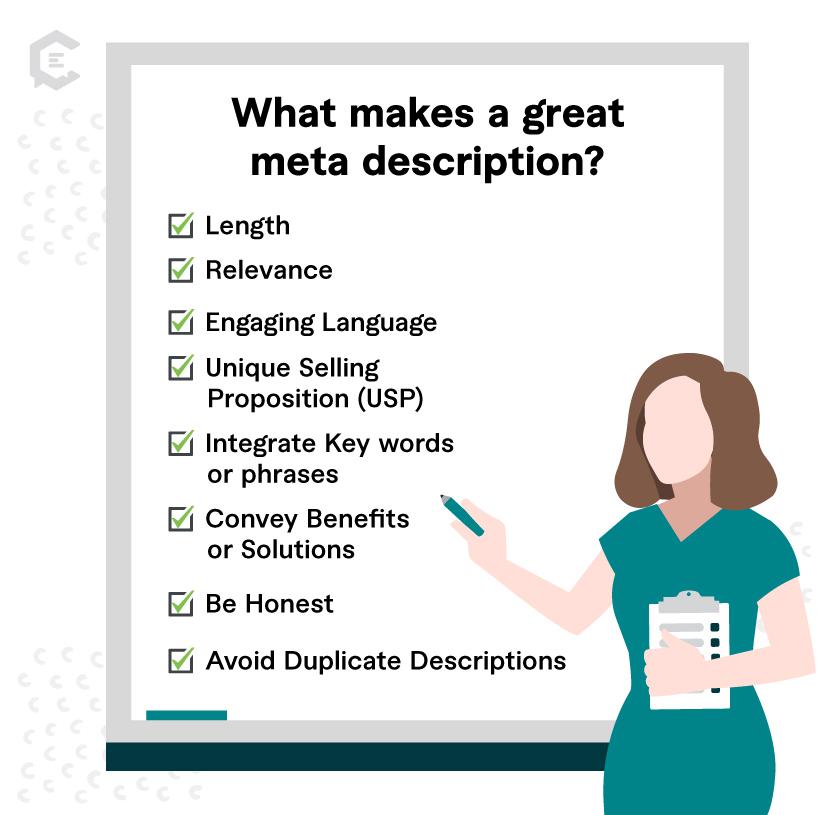What is a meta description?
A meta description is a snippet of text that summarizes the content of a web page. When you include them in your page’s HTML code, they appear as a short summary below your hyperlink on search engines. They offer a concise preview of your page and entice viewers to click.
And they don’t just appear in search engines. Social media sites like Facebook and LinkedIn pull in your title and meta description to their preview when your pages are shared there.
Although you definitely want your meta descriptions optimized for search, Google doesn’t use them as a ranking signal. But, a well-crafted and relevant description can improve the click-through rate (CTR) from search results. Always be sure to make them concise, ranging from 50 to 160 characters in length.
Why are meta descriptions so important?
Meta descriptions drive higher click-through rates by properly setting audience expectations.
They help customers scan their search results by reading through brief descriptions. That makes it easier for them to decide which page best matches their query. Meta descriptions are like a trailer for a movie. They save users time by previewing the coming attractions.
They also allow you to establish your brand’s voice and unique selling propositions. They’re a great place to include a call to action (CTA) and help differentiate yourself from your competition.
What makes a great meta description?
A great meta description aims to set clear expectations about your page’s content concisely. To do that, here are a few key components that make a compelling meta description:
- Length: Meta descriptions max out at 160 characters. Keep it short. And double-check your character length to ensure your description isn’t cut off.
- Relevance: Your meta description is there to reflect the page’s content. Misleading or irrelevant descriptions may lead to high bounce rates.
- Engaging Language: Be sure to highlight the value and benefits of your content to capture a user’s interest.
- Unique Selling Proposition (USP): Include your page’s unique selling points like special features, exclusive information, or any other factor that makes your content valuable.
- Integrate Key words or phrases: Incorporating relevant keywords that match users’ search queries is a huge advantage. While meta descriptions don’t directly impact SEO, users are likelier to click on links that match the terms they’re searching.
- Convey Benefits or Solutions: By highlighting what users can gain by visiting your page, you make it clear your content addresses their needs or answers their questions.
- Be Honest: Avoid hyperbolic language, and don’t make any promises your content cannot deliver. If you are honest about what users can expect to find on your page, you’ll build more trust and credibility with your audience.
- Avoid Duplicate Descriptions: Each meta description on your website should be unique. If you have the same description across multiple pages, it can confuse users and search engines.
Google may rewrite your descriptions
Your meta description and meta title are featured in your HTML code, making them accessible for optimization by the Google team. According to a recent study examining search results spanning 30,000 keywords, Google rewrites up to 70% of meta descriptions.
Why is Google hijacking our descriptions? Google’s primary goal is to deliver the most relevant search results that match a user’s query. They want a clean and effective search engine results page to keep their customers happy. Sometimes that means making a description more uniformly aligned with current practices.
It may also mean that your description does not accurately describe the content of your page. It could also have flagged your description for keyword stuffing. Whatever the reason for rewriting your description, the goal is always to make it more effective for its users.
Does it still pay to spend time writing out excellent, optimized meta descriptions? Yes, it still does. You have no way of knowing when Google will rewrite them or for which pages. So, it’s best to have great ones in place.
A great example
The meta description for your home page is an excellent investment of your time. A branded description for a page is less likely to be rewritten by Google. Here is a great example of a meta description for a jewelry company:
“Sparkle and Shine with Our Exquisite Handcrafted Jewelry Collection – Discover Timeless Elegance and Unmatched Craftsmanship. Shop Now for Unforgettable Gifts.”
The meta description starts with the attention-grabbing phrase, “Sparkle and Shine.” That captures the reader’s interest and evokes a positive emotion. By highlighting “Exquisite Handcrafted Jewelry Collection” and “Unmatched Craftsmanship,” the meta description emphasizes the quality and artistry of the jewelry. Finally, it closes out with a clear call to action, all under 160 characters. Most importantly, it accurately describes the page they’re about to visit.
Take Your Meta Descriptions to the Next Level
Overall, a meta description is there to effectively communicate what your page has to offer. Keep it concise with a clear call to action, and your click-through rate will go through the roof. And if Google rewrites your meta description, don’t sweat it. It’ll ultimately work in your favor when you appear more clearly on the search engine results page (SERP).
If you’re looking to elevate the SEO content for your site and craft click-worthy meta descriptions, we’re here to help. Talk to a content specialist at ClearVoice today to get started.





